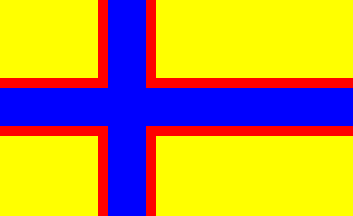
Last modified: 2021-08-26 by valentin poposki
Keywords: ingria | inkeri | inkerinmaa | ingermanland | finland | cross: scandinavian (blue) |
Links: FOTW homepage |
search |
disclaimer and copyright |
write us |
mirrors

The Ingrian flag (which was official when the Ingrians had some authonomy
in the 1920s and 30s) being yellow with a blue scandinavian cross with red
finbrations; colours taken from the old arms of Ingria.
Elias Granqvist, 25 Aug 2000
This flag, with medium blue cross, is listed under number 83 at the chart
Flags of Aspirant Peoples [eba94] as:
«Ingria [Inkeri] (Ingrians) - St Petersburg’s area, West
Russia».
Ivan Sache, 15 Sep 1999 and 28 Apr 2000
Ingria is the area southwest of St. Petersburg
in Russia. The area belonged to Sweden
between 1617 and 1721, and was populated by “good
Swedes” moved in from Finland
(Karelia). Consequently, the area had
a Finnish speaking population. Most of them fled to Finland after the
wars between Finland and the USSR. After the first World War, however,
the area gained limited self rule within Russia, and a flag was adopted.
Jan Oskar Engene, 20 Mar 1996
Ingermanland is the Swedish name
for the former province. The Ingrians themselves
call the place Inkeri. The language is
very close to Finnish, but is I believe
categorised separately rather than as a dialect.
So far as I know there are only about 400 native
speakers left so that puts them in the same
category as the Livs
(another Finno-Ugric nation).
James Oates, 13 Aug 1999
In Ingermanland, which name is of Scandinavian origin (Finnish
Inkerinmaa - the land of Princess Ingrid), live around
Petersburg till Lake Ladoga and southwest till Jamburg [Narva-Joesuu?]
the Lutheran Äyrämöiset and Savakot in small groups next
to each other. Their forebears migrated here probably in the 14th century
and later out of south Karelia and south Finland.
Jarig Bakker, 25 Aug 2000,
quoting from Die Völker Europas,
by Georg Buschan, c. 1910
Ingria is not the same area as the parts of Finnish Karelia
ceded in 1940. Rather it was the coastal strip between
Estonia and
Finland (pre-1940 boundary), roughly contiguous to the
St. Petersburg / Leningrad province but not
quite as extensive into the hinterland. I also recall once reading in
a reference book (possibly an old copy of the Encyclopedia
Brittanica) that as late as the 1890s some 90% of the rural population
of St. Petersburg government [meaning "province"]
was Finnish-speaking, as was some 10% of the city’s population.
From that point though, rapid industrialisation appears
to have cemented the Russification of the area.
As I understand it, Stalin had the remaining Ingrians deported during
the 30s. Have they now returned in sufficient numbers to agitate for
changes? I also recall reading that at the end of the Winter War, when
the Finnish population in the ceded areas was given a week to decide whether
to decamp to the remainder of Finland or stay and become Soviet citizens,
all but a handful left.
Roy Stilling, 18 Sep 1995
The only active Ingrian group I’m aware of is an emigré
group operating in Finland itself. But my information of them dates from
before the collapse of the USSR, so things may have changed.
Stuart Notholt, 19 Sep 1995